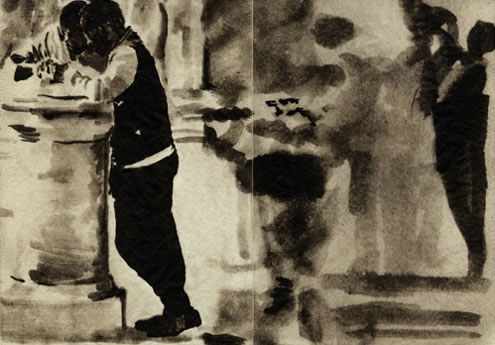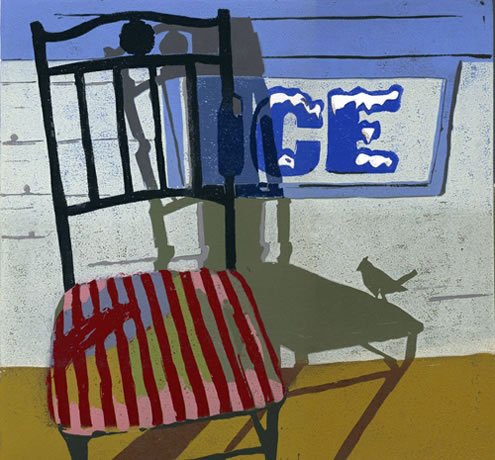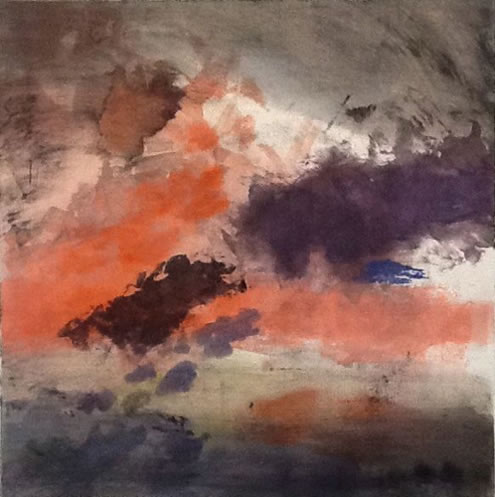Zea Mays Printmaking
[substratum] An Artistic Inquiry into Printmaking Substrates and their Health Impacts
Zea Mays Printmaking, based in Florence, MA, has designed and launched a website as its Prospectus project, entitled [substratum] An Artistic Inquiry into Printmaking Substrates and their Health Impacts. The website centers on five “substrates” — five different materials (wood, linoleum, metal, plastic and photopolymer) that make up printmaking plates —and the health issues associated with use of these materials in the studio, home and office. Information about these health issues is often difficult to access and understand; therefore, the organization has created a multilayered, multimedia website that features new art by the seven artist-members of the Zea Mays Printmaking working group displaying human physical systems, material data safety sheets, personal audio-recorded stories and web links that educate artists and DIY practitioners alike about potential health impacts and safety precautions that should be taken when using the materials. The Zea Mays artists worked with scientists and toxicologists Dr. David Hinkamp and Dr. Richard Peltier in conducting the research that has gone into the [substratum] website.Zea Mays Printmaking, [substratum] Working Group
Judith Bowerman grew up in Michigan near Lake St. Clair and the Detroit River, where she was first drawn to the quietude of water. After attending college near the dunes of Lake Michigan, she moved to Northern California for further training in painting and printmaking. The Pacific Ocean taught her about the absolute power and drama of water, and the coastal redwoods inspired her with a new sense of sublime scale. Longing to return to four distinct seasons, she moved to Western Massachusetts one snowy November and did not see green grass until after the mud season in early April the following year. In the 34 years since, the perpetual yet unpredictable seasonal changes of New England have continued to captivate her. As an active artist and teacher, she raised three vibrant daughters in Springfield, MA, with her husband and fellow artist Larry Slezak. The two recently moved to a farm in Cummington, MA, surrounded by gardens, pastures, woods and streams. Judith works daily in her rural studio, where the view encompasses grazing sheep and a massive glacial rock.

Judith Bowerman, Entwined, monoprint
Liz Chalfin is the founder and director of Zea Mays Printmaking. She began her journey into safer printmaking as a teacher at Whittier College (CA) in the early 1990s. In 1997 she moved to Massachusetts and started a small studio for working artists interested in safer methods of making prints. That modest endeavor has blossomed over the years into Zea Mays Printmaking, one of the country’s largest “green” printmaking studios and a resource for artists from all over the world. Liz’s own artistic practice includes etching and photo-intaglio printmaking, works on paper and artist’s books.

Liz Chalfin, Another Day, page 2, intaglio
Pamela Crawford: “With color I define form or distinguish layers while changing ink viscosities and drawing form textures. All of my prints shadow my life and become a kind of visual expression of my current — even daily — struggle or celebration. I work spontaneously, without detailed planning, to sincerely represent a piece of my inner life. Within this construct, I attempt to illustrate certain realities of our existence: predatory and invasive behavior; biological patterns and structure; human growth and disintegration. And, most importantly, the beauty of heterogeneous elements coming together to form something exquisite.” Education: University of Massachusetts, Boston, MA: B.A., Art, Summa cum laude, 1993; The Art Institute of Boston, Boston, MA: Graphic Design, Honors graduate, 1984; Ringling School of Art & Design, Sarasota, FL: Foundation Year, 1981.

Pamela Crawford, May Day 1996, etching
Nancy Diessner‘s artwork emerges from her background in painting, printmaking, drawing, photography and digital image manipulation. Incorporating all these media, her photopolymer intaglio prints explore the mysterious and complex connection between humans and animals at the same time expressing our human longing for and isolation from the “other.” Dedicated to safer printmaking, she created two low-toxicity printmaking studios during her 17-year college teaching career and now runs a public printmaking studio, Dog’s Eye Print Studio, in Framingham, MA, where she also makes photopolymer plates for artists.

Nancy Diessner, Second Elegy, photo intaglio
Susan Jaworski-Stranc: “I have been creating linoleum relief prints for over 30 years; untutored and self-educated. Although I studied printmaking in art school with a concentration in intaglio techniques, I turned my attention to linoleum relief printmaking when I became pregnant and a mother for the first time. I loved making prints, but was well versed in printmaking’s toxicity. I wanted to keep my hands ‘printmaker dirty,’ but in a safe, responsible and healthy way both for myself and for my unborn and future family. And so began my journey into relief printmaking, the oldest form of printing, with the purchase of woodblocks of mounted linoleum, tubes of water soluble inks and a set of gouges. Banished from my studio were VOCs, corrosive acids and petroleum products. I felt I had created a safe art environment for my creative endeavors and my children. After many years working with the linoleum, I made a horrifying observation when leafing through an art supplies catalogue. In parentheses next to the item ‘battleship grey linoleum’ read ‘(contains no asbestos).’ WHAT?! I thought my substrate was innocuous, safe. Was it toxic to my health? Did I have a false sense of security when working with this material? With some research, I learned true linoleum has no asbestos. Battleship linoleum gets its name from the color of naval ships, and it was just about the only sheet flooring available before the 1960s. Plenty of products get used in situations they weren’t designed for. Know your print substrate. Do your research, ask questions.”

Susan Jaworski-Stranc, Harbinger, reduction linocut
Lynn Peterfreund: “In the 40 years I’ve worked as a printmaker, painter and art instructor, I’ve used a variety of materials and a variety of styles and subjects. The health aspects of using paints, inks and solvents have prompted many of the changes in media that I’ve made. Although I haven’t suffered specific consequences of the reckless, albeit blissfully ignorant, practices of art school studios, I made choices early on to get myself out of the toxic haze of free flowing solvents and into studios with controlled and increasingly healthy use of alternative materials. Being a part of a green studio allows me to return to intaglio printmaking in addition to doing monotype, a technique with fewer chemical processes.
“Most of my work has been a response to the world I experience: nature and culture,people and animals. I work in series, often for two or three years, looking for variations in description and interpretation of my chosen subject. I worked for many years primarily from observation, doing still life, landscape and portraits. That vocabulary of forms has been my inspiration for a decade of more geometric, abstract work. In the last few years, I have combined what I love about working with color and composition with a return to using representational forms. My two recent print series are A Murder of Crows, and Eco.ominous, gestural monotypes suggesting colorful abstracted moody skies that portend the changes and obstacles of modern life on our planet.”

Lynn Peterfreund, Eco.ominous 8, monotype
Joyce Silverstone is an artist printmaker based in Massachusetts. She grew up in the Midwest, studying art in Cleveland, and is a graduate and a traveling fellow of The School of the Museum of Fine Arts, Boston. An active artist for more than 30 years, she exhibits her work nationally and internationally. Joyce is affiliated with Zea Mays Printmaking, where she is an instructor and studio monitor. Her current work is represented in the studio’s Flat File Project, and at Printroom, London. Her paintings and prints are held in private and corporate collections in New England and in numerous permanent collections, including that of Yale University Art Gallery, MIT Art Gallery, the Decordova Museum, the Hood Art Museum and the Portland Museum of Art.

Joyce Silverstone, Lineage, monotype
Zea Mays Printmaking is a studio, workshop, gallery, educational facility and research center dedicated to the safest and most sustainable printmaking practices available. “We are continually researching exciting new techniques and products. We share this information through our workshops, consultations and private tutorials.”

![[substratum] Working Group, [substratum] 4, 2012](http://artistsincontextprospectus.org/wp-content/uploads/2013/05/zea_substratum4_lowrez.jpg)

